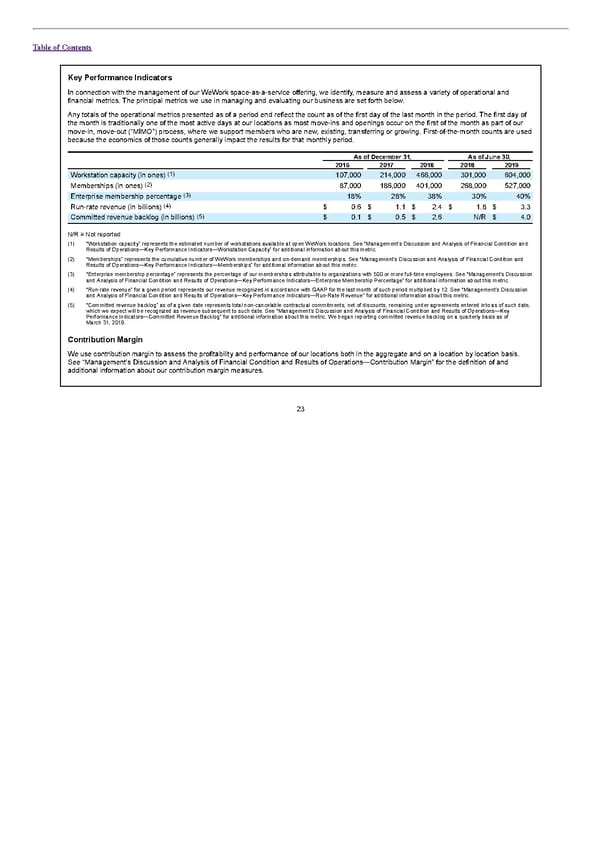Table of Contents Key Performance Indicators In connection with the management of our WeWork space-as-a-service offering, we identify, measure and assess a variety of operational and financial metrics. The principal metrics we use in managing and evaluating our business are set forth below. Any totals of the operational metrics presented as of a period end reflect the count as of the first day of the last month in the period. The first day of the month is traditionally one of the most active days at our locations as most move-ins and openings occur on the first of the month as part of our move-in, move-out (“MIMO”) process, where we support members who are new, existing, transferring or growing. First-of-the-month counts are used because the economics of those counts generally impact the results for that monthly period. As of December 31, As of June 30, 2016 2017 2018 2018 2019 (1) Workstation capacity (in ones) 107,000 214,000 466,000 301,000 604,000 (2) Memberships (in ones) 87,000 186,000 401,000 268,000 527,000 (3) Enterprise membership percentage 18% 28% 38% 30% 40% (4) Run-rate revenue (in billions) $ 0.6 $ 1.1 $ 2.4 $ 1.8 $ 3.3 (5) Committed revenue backlog (in billions) $ 0.1 $ 0.5 $ 2.6 N/R $ 4.0 N/R = Not reported (1) “Workstation capacity” represents the estimated number of workstations available at open WeWork locations. See “Management’s Discussion and Analysis of Financial Condition and Results of Operations—Key Performance Indicators—Workstation Capacity” for additional information about this metric. (2) “Memberships” represents the cumulative number of WeWork memberships and on-demand memberships. See “Management’s Discussion and Analysis of Financial Condition and Results of Operations—Key Performance Indicators—Memberships” for additional information about this metric. (3) “Enterprise membership percentage” represents the percentage of our memberships attributable to organizations with 500 or more full-time employees. See “Management’s Discussion and Analysis of Financial Condition and Results of Operations—Key Performance Indicators—Enterprise Membership Percentage” for additional information about this metric. (4) “Run-rate revenue” for a given period represents our revenue recognized in accordance with GAAP for the last month of such period multiplied by 12. See “Management’s Discussion and Analysis of Financial Condition and Results of Operations—Key Performance Indicators—Run-Rate Revenue” for additional information about this metric. (5) “Committed revenue backlog” as of a given date represents total non-cancelable contractual commitments, net of discounts, remaining under agreements entered into as of such date, which we expect will be recognized as revenue subsequent to such date. See “Management’s Discussion and Analysis of Financial Condition and Results of Operations—Key Performance Indicators—Committed Revenue Backlog” for additional information about this metric. We began reporting committed revenue backlog on a quarterly basis as of March 31, 2019. Contribution Margin We use contribution margin to assess the profitability and performance of our locations both in the aggregate and on a location by location basis. See “Management’s Discussion and Analysis of Financial Condition and Results of Operations—Contribution Margin” for the definition of and additional information about our contribution margin measures. 23
 S1 - WeWork Prospectus Page 27 Page 29
S1 - WeWork Prospectus Page 27 Page 29